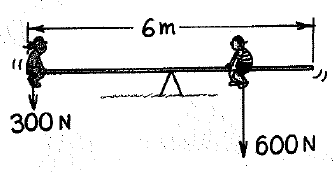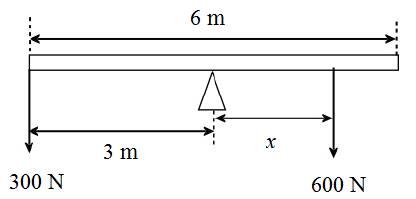
a. Calculate the individual torques produced by the weights of the girl and boy on the seesaw in the figure. What is the net torque?
b. Calculate the distance a 600-N boy should sit from the fulcrum.
c. Calculate the distance a 300-N girl should sit when the boy weighs 400 N.

(a)
The individual torques produced by the weights of the girl and the boy and the net torque.
Answer to Problem 25A
The torque produced by the weights of the girl is
The torque produced by the weights of the boy is
The net torque produced is
Explanation of Solution
Given info:
The weight of the girl is
The weight of the boy is
Formula used:
The expression for the torque as follows:
Here,
Calculation:
Sketch the free body diagram of the system as shown below.

Refer to Figure.
The torque produced by the
Hence, the torque produced by the weights of the girl is
The distance x as follows:
The torque produced by the
Hence, the torque produced by the weights of the boy is
The net torque as follows:
Hence, the net torque is
Conclusion:
Thus, the torque produced by the weights of the girl is
Thus, the torque produced by the weights of the boy is
Thus, the net torque produced is
(b)
The distance of the
Answer to Problem 25A
The distance of the
Explanation of Solution
Given info:
The weight of the girl is
The weight of the boy is
Calculation:
The distance x is as follows:
Conclusion:
Thus, the distance of the
(c)
The distance of the
Answer to Problem 25A
The distance of the
Explanation of Solution
Given info:
The weight of the girl is
The weight of the boy is
Calculation:
Consider the girl sits from the fulcrum at a distance d.
Find the distance x as follows:
Conclusion:
Thus, the distance of the
Chapter 11 Solutions
CONCEPTUAL PHYSICS-W/PRACTICING PHYSICS
Additional Science Textbook Solutions
Introductory Chemistry (6th Edition)
Chemistry: The Central Science (14th Edition)
Genetic Analysis: An Integrated Approach (3rd Edition)
Applications and Investigations in Earth Science (9th Edition)
Campbell Biology (11th Edition)
Cosmic Perspective Fundamentals
- Taking a Hike A hiker begins a trip by first walking 21.0 km southeast from her car. She stops and sets up her tent for the night. On the second day, she walks 46.0 km in a direction 60.0° north of east, at which point she discovers a forest ranger's tower. y (km) Can N W-DE 45.0° 60.0° Tent Tower B x (km) ☹ (a) Determine the components of the hiker's displacement for each day. SOLUTION Conceptualize We conceptualize the problem by drawing a sketch as in the figure. If we denote the displacement vectors on the first and second days by A and B, respectively, and use the ---Select-- as the origin of coordinates, we obtain the vectors shown in the figure. The sketch allows us to estimate the resultant vector as shown. Categorize Drawing the resultant R, we can now categorize this problem as one we've solved before: --Select-- of two vectors. You should now have a hint of the power of categorization in that many new problems are very similar to problems we have already solved if we are…arrow_forwardPlz plz no chatgpt pls will upvote .arrow_forwardYou want to determine if a new material created for solar panels increases the amount of energy that can be captured . You have acquired 15 panels of different sizes manufactured with different materials including the new material.You decide to set up an experiment to solve this problem .What do you think are the 3 most important variables to address in your experience? How would you incorporate those materials in your experiment?arrow_forward
- 7. Are all scientific theories testable in the commonly understood sense? How does this make you feel? How should you proceed as a scientist or engineer with this understanding?arrow_forwardWhat is an an example of a hypothesis that sounds scientific but is notarrow_forwardWhat is an example of a scientific hypothesisarrow_forward
- Multiverse is called a theory. It has been proposed to account for the apparent and uncanny fine tuning of our own universe. The idea of the multiverse is that there are infinite, distinct universes out there - all with distinct laws of nature and natural constants - and we live in just one of them. Using the accepted definition of the universe being all that there is (matter, space and energy), would you say that multiverse is a scientific theory?arrow_forwardHow is a law usually different than a theoryarrow_forwardA 1.50 mLmL syringe has an inner diameter of 5.00 mmmm, a needle inner diameter of 0.270 mmmm, and a plunger pad diameter (where you place your finger) of 1.2 cmcm. A nurse uses the syringe to inject medicine into a patient whose blood pressure is 140/100. Part A What is the minimum force the nurse needs to apply to the syringe? Express your answer with the appropriate units. View Available Hint(s)for Part A Hint 1for Part A. How to approach the question The force the nurse applies to the syringe can be determined from the fluid pressure and the area of the plunger. The minimum force corresponds to the patient's lowest blood pressure. Use the following equality 760mmofHg=1atm=1.013×10^5Pa760mmofHg=1atm=1.013×10^5Pa.arrow_forward
 College PhysicsPhysicsISBN:9781305952300Author:Raymond A. Serway, Chris VuillePublisher:Cengage Learning
College PhysicsPhysicsISBN:9781305952300Author:Raymond A. Serway, Chris VuillePublisher:Cengage Learning University Physics (14th Edition)PhysicsISBN:9780133969290Author:Hugh D. Young, Roger A. FreedmanPublisher:PEARSON
University Physics (14th Edition)PhysicsISBN:9780133969290Author:Hugh D. Young, Roger A. FreedmanPublisher:PEARSON Introduction To Quantum MechanicsPhysicsISBN:9781107189638Author:Griffiths, David J., Schroeter, Darrell F.Publisher:Cambridge University Press
Introduction To Quantum MechanicsPhysicsISBN:9781107189638Author:Griffiths, David J., Schroeter, Darrell F.Publisher:Cambridge University Press Physics for Scientists and EngineersPhysicsISBN:9781337553278Author:Raymond A. Serway, John W. JewettPublisher:Cengage Learning
Physics for Scientists and EngineersPhysicsISBN:9781337553278Author:Raymond A. Serway, John W. JewettPublisher:Cengage Learning Lecture- Tutorials for Introductory AstronomyPhysicsISBN:9780321820464Author:Edward E. Prather, Tim P. Slater, Jeff P. Adams, Gina BrissendenPublisher:Addison-Wesley
Lecture- Tutorials for Introductory AstronomyPhysicsISBN:9780321820464Author:Edward E. Prather, Tim P. Slater, Jeff P. Adams, Gina BrissendenPublisher:Addison-Wesley College Physics: A Strategic Approach (4th Editio...PhysicsISBN:9780134609034Author:Randall D. Knight (Professor Emeritus), Brian Jones, Stuart FieldPublisher:PEARSON
College Physics: A Strategic Approach (4th Editio...PhysicsISBN:9780134609034Author:Randall D. Knight (Professor Emeritus), Brian Jones, Stuart FieldPublisher:PEARSON





